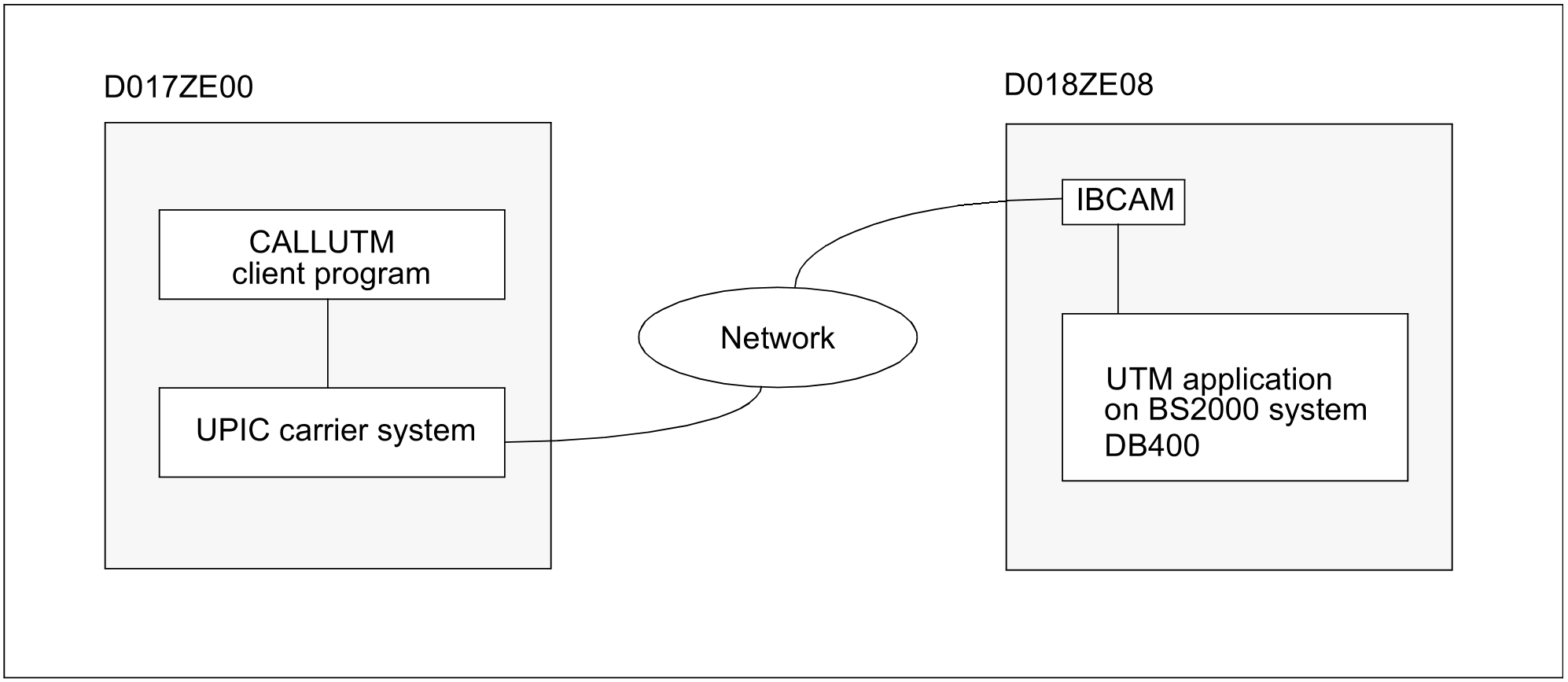To use CALLUTM to administer UTM applications, proceed as follows:
In the local BS2000 system: In the “side information file” (also known as the UPICFILE) for the UPIC carrier system, you create the corresponding entries for the UTM applications (see the manual “openUTM-Client for the UPIC Carrier System“).
In each UTM application to be administered you must make PTERM entries and LTERM partner entries in the relevant configurations or generate an LTERM pool via which CALLUTM can connect.
You need to create at least one user ID with administration privileges in each UTM application that you want to administer for this (see example below). CALLUTM must pass this user ID (along with the relevant password) to the UTM application when establishing the conversation. The CALLUTM statement CREATE-CONFIGURATION contains the operands USER-ID and PASSWORD for this (see "Description of CALLUTM program statements (BS2000 systems)").
You can also assign the LTERM partner through which CALLUTM links up with the UTM application an user ID with administration privileges (LTERM ...,USER=). CALLUTM then does not need to pass a user ID to the UTM application and has administration privileges when establishing the connection. Bear in mind, however, that this approach will reduce access control for the UTM application.
Example
The CALLUTM program on the BS2000 computer D017ZE00 is to communicate with the application DB400 on the BS2000 computer D018ZE08.
Sample configuration for using the program CALLUTM
KDCDEF generation for the UTM application on the DB400 computer BS2HOSTA:
There are to be two ways in which CALLUTM can connect to the UTM application:
via an LTERM pool. If CALLUTM connects via the LTERM pool, CALLUTM will be unable to start any administration commands and TACs for which administration privileges are required.
via an LTERM partner generated explicitly for the purpose of working together with CALLUTM. To this end, a PTERM statement, an LTERM statement and a USER statement must be issued for CALLUTM in the UTM application.
The user ID (USER ADMUPCT0) must have administrator privileges and be assigned to the LTERM partner.
*****
*- BCAMAPPL FOR CONNECTING CALLUTM VIA AN LTERM POOL
*****
BCAMAPPL DB4UPAP0,T-PROT=ISO
*****
*- BCAMAPPL FOR CONNECTING CALLUTM VIA A DEDICATED LTERM PARTNER
*****
BCAMAPPL DB4UPAT0,T-PROT=ISO
*****
*- LTERM POOL FOR CONNECTING CALLUTM -----------------------------*
*****
TPOOL BCAMAPPL=DB4UPAP0,KSET=ALLKEYS,LTERM=UPCP0#0,NUMBER=9, -
PRONAM=D017ZE00,PROTOCOL=N,PTYPE=UPIC-R
*****
*- DEFINE PTERM STATEMENT, LTERM PARTNER AND USER ID WITH --------*
*- ADMINISTRATION PRIVILEGES FOR CALLUTM -------------------------*
*****
PTERM UPCPT#T0, PRONAM=BS2HOSTC, PTYPE=UPIC-R, -
BCAMAPPL=DB4UPAT0, PROTOCOL=N, LTERM=UPCLT#T0
LTERM UPCLT#T0, KSET=ALLKEYS, USER=ADMUPCT0, RESTART=N
* USER ID WITH ADMINSTRATOR PRIVILEGES ----------------------------
USER ADMUPCT0, PERMIT=ADMIN, PASS=(ADMT0 ,D)
*****
*-----------------------------------------------------------------*
*****
Entries in the UPICFILE
Connecting CALLUTM to a UTM application
CALLUTM links up to the UTM application DB400 on the BS2HOSTA computer via the LTERM partner UPCLT#T0, if you make the following entries in CALLUTM when establishing the connection:
local name = UPCPT#T0symbolic destination name = DBSADMT0„UPCPT#T0“ is passed to openUTM as the client name (PTERM name).
The symbolic partner name DBSADMT0 is linked to the partner name DB4UPAT0 from the UPICFILE. That is the name of the UTM application DB400, as specified in BCAMAPPL during the KDCDEF generation.
CALLUTM links up to the UTM application via the LTERM pool, if you make the following entries when establishing the connection:
local name = locnamesymbolic destination name = DBS0POOL or DBS1POOLEnter an alphanumeric name (up to 8 bytes long) for locname with which CALLUTM signs on with the transport system. This name is passed on to openUTM as the client name when the connection is established and it will be assigned to an LTERM partner of the LTERM pool for the duration of the connection.
The symbolic partner name DBS0POOL or DBS1POOL is linked to the partner name DB4UPAP0 from the UPICFILE. That is the name of the UTM application DB400 as entered in BCAMAPPL during the KDCDEF generation.
Calling CALLUTM as an administrator program in a BS2000 task
You can call CALLUTM via the SDF command START-CALLUTM. This command can be found in the SDF UTM application area. For further information, see the openUTM manual “Using UTM Applications on BS2000 Systems”, section “Calling UTM tools”.
The communication to the server is possible with or without encryption.
Example (call via START-CALLUTM)
In the following example CALLUTM is to terminate the UTM application DB400 on the BS2HOSTA computer. For this you must first start CALLUTM and sign on to the UTM application DB400 using the user ID ADMUPCT0, which has administrator privileges. To terminate the application, you issue the UTM administration command KDCSHUT NORMAL.
To do that you must you must enter the following sequence of program statements. The program statements will be described in detail below.
/START-CALLUTMBy default, communication with the server is handled over a Socket connection. If CMX is to be used, you can use the following command.
//CREATE-CONFIGURATION LOCAL-NAME=UPCPT#T0, -
/ SYMB-DEST-NAME=DBSADMT0
//SELECT-SERVICE SERVICE-NAME=KDCSHUT, SERVICE-DATA='NORMAL'
//END
/START-CALLUTM TRANSPORT-SYSTEM=*CMX


